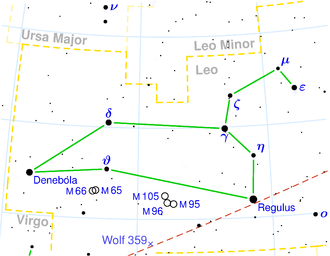NGC 3121
| Galaxy NGC 3119 / NGC 3121 |
|
|---|---|

|
|
| SDSS recording | |
| AladinLite | |
| Constellation | lion |
|
Position equinox : J2000.0 , epoch : J2000.0 |
|
| Right ascension | 10 h 07 m 11.5 s |
| declination | + 14 ° 22 ′ 25 ″ |
| Appearance | |
| Morphological type | E. |
| Brightness (visual) | 12.9 mag |
| Brightness (B-band) | 13.9 likes |
| Angular expansion | 1.7 ′ × 1.4 ′ |
| Position angle | 20 ° |
| Surface brightness | 13.9 mag / arcmin² |
| Physical data | |
| Redshift | 0.029437 ± 0.000017 |
| Radial velocity | (8825 ± 5) km / s |
|
Stroke distance v rad / H 0 |
(390 ± 27) · 10 6 ly (119.5 ± 8.4) Mpc |
| history | |
| discovery | William Lassell |
| Discovery date | March 31, 1848 |
| Catalog names | |
| NGC 3119/3121 • UGC 5450 • PGC 29387/93103 • CGCG 093-046 • MCG + 03-26-027 • 2MASX J10065190 + 1422247 • LDCE 0707 NED003 | |
NGC 3121 = NGC 3119 is a merging pair of Hubble type E galaxies in the constellation Leo on the ecliptic . It is around 390 million light years from the Milky Way .
The object was discovered by William Lassell on March 31, 1848 . In the literature database, NGC 3119 is often equated with PGC 29381 .
